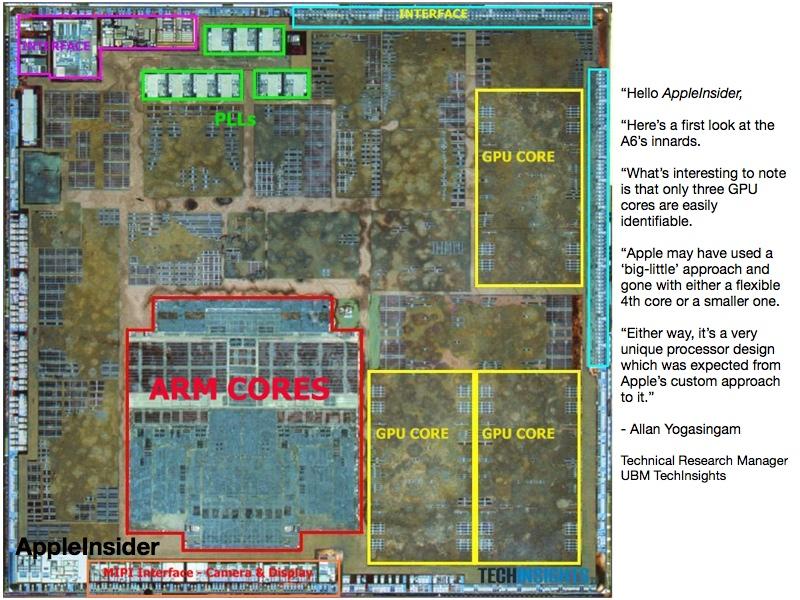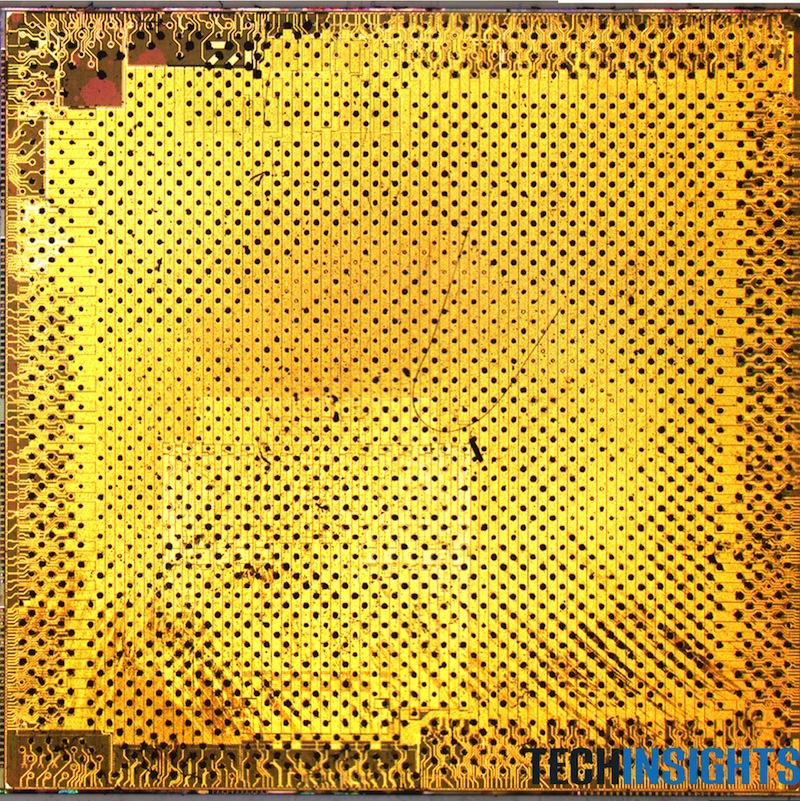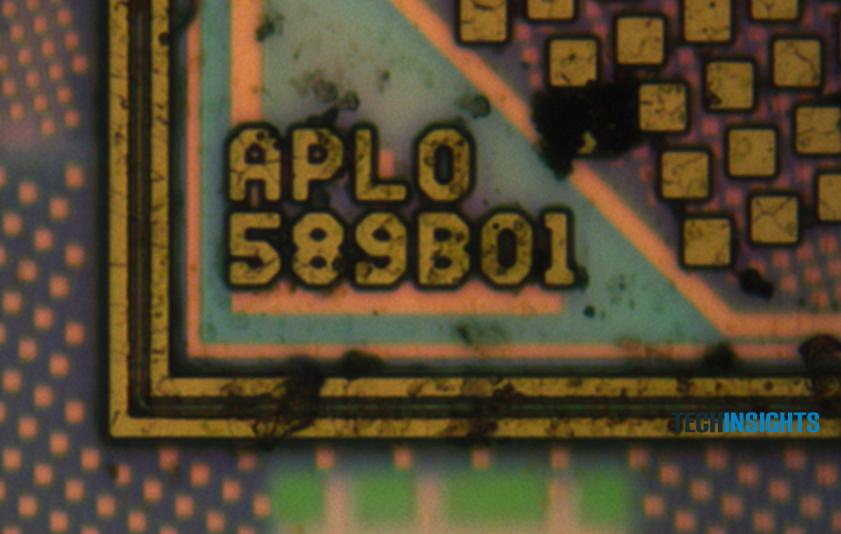First look inside Apple's new iPhone 5 A6 chip appears to show 3 GPUs, 2 CPUs
Last updated
Apple's new iPhone 5 A6 chip appears to have 3 GPUs, 2 CPUs
The first internal images of the new chip's layout, released by TechInsights, shows three "easily identifiable" GPUs cores, although the firm noted that "Apple may have used a 'big-little' approach and gone with either a flexible 4th core or a smaller one."
The chip also appears to use dual general purpose ARM cores, although it is known that Apple didn't use either of ARM's stock Cortex-A8 or Cortex-A15 designs. Instead, Apple developed its own custom variant optimized for its own uses.
Origins of ARM
ARM has served as a processor IP design firm for decades since being founded as a collaboration between Apple, the British Acorn and California chip maker VLSI in the early 1990s to adapt Acorn's RISC chip for use in mobile devices (specifically targeting Apple's 1994 Newton Message Pad).
Every since, ARM has licensed its processor designs to third parties to fabricate. Some licensees only have rights to build ARM's existing designs, but Apple acquired the rights to develop custom versions of ARM's CPU core technologies in obtaining "a long-term architecture license to ARM's current and future technology for use in mobile computing,"
Along with ARM's CPU cores, Apple also secretly inked a "multi-use licensing agreement" with Imagination Technologies in 2007, giving it access to the firm's "next generation graphics and video IP cores."
In early 2008, AppleInsider was the first to report that the "international electronics systems company" making these secret deals was, in fact, Apple.
A is for Apple
Critics scoffed at the idea that Apple could develop its own custom chips, ignoring its series of chip design acquisitions and the increasing sophistication and customization apparent in its A-series chips to suggest that the company has really only been putting its brand name on Samsung's chip designs.
All of Apple's A-series chips to date have all been manufactured by Samsung, which is one of the world's few highly sophisticated chip fabricators capable of producing the large numbers of chips Apple needs to power the tens of millions of iPods, iPhones, iPads, Apple TVs and AirPort base stations it sells every quarter.
While Apple began using Samsung-built 8900B application processors in its first two generations of iPhone, it shifted to a series of "APL" chips in 2008 and 2009.
Apple's acquisition of PA Semi in 2008, followed by its purchase of Intrinsity in 2010 enabled the company to deliver a series of increasingly customized application processor chips for iOS devices. The original iPad shipped with the first SoC Apple branded with its own "A4" moniker.
The company's A-series chips incorporate processor cores based on IP from both ARM and Imagination, along with other customizations, such as the on-chip integration of Audience EarSmart noise reduction technology in last year's A5, which provided the hardware powering the iPhone 4S' Siri feature.
Apple has since apparently created its own noise reduction technology as it continues to optimize its designs.
Will Apple abandon Samsung?
In a previous report, UBM TechInsights noted that, "where the A6 is being fabricated was also a mystery."
While it said that "an early analysis of the die markings of the A6 reveal markings that are similar to the Samsung markings found in the A4 and A5 processors," it also noted that the very small overall size of the new chip suggested a move to a much smaller manufacturing process, potentially in a partnership with rival chip fab TSMC.
In taking a closer look at the chip, the firm is now confident in saying that "the markings show it is Samsung and the die itself is 95.04 sq mm in area."
That's much smaller than the 165 sq mm A5X used in the new iPad, which incorporates quad core graphics and dual core CPUs, or the 122.6 sq mm dual core A5 used in last year's iPhone 4S and iPad 2.
Making chips smaller helps contribute to their power efficiency (shorter distances for electrons to travel) and cost (uses less silicon), but also requires more exacting technology.
UBM TechInsights also noted that on the iPhone 5 it examined, Apple had used 32GB of NAND storage flash memory from SanDisk and 1GB of system "processor on package" memory (integrated onto the A6) from Elpida. While Apple commonly sources components like RAM from multiple companies, the fact that Apple isn't even using Samsung memory on the Samsung built A6 hints at efforts Apple is making to diversify its business away from Samsung.
This summer, Apple revealed in a lawsuit against Samsung evidence showing that Samsung's chip making unit had developed a report showing how the company's phone unit could easily copy Apple's hardware designs, followed by internal reports within the company's phone unit that documented efforts to solve the firms "crisis of design" in a three month effort to duplicate the iPhone as closely as possible.
Samsung has since tried to promote the idea that its chip manufacturing business is protected by a " strict internal firewall" that prevents similar improprieties involving corporate espionage and the cloning of its own customers' products by other parts of the Korean conglomerate's vast business dealings, but it appears Apple is equally as ready to abandon its partnerships wherever possible with Samsung as it is to separate itself from Google.
 Daniel Eran Dilger
Daniel Eran Dilger

















 Amber Neely
Amber Neely
 Thomas Sibilly
Thomas Sibilly
 AppleInsider Staff
AppleInsider Staff
 William Gallagher
William Gallagher
 Malcolm Owen
Malcolm Owen
 Christine McKee
Christine McKee










36 Comments
The Next Big Thing Is Already Here:
Galax....
oh wait,
"iPhone 5 Benchmarked: The Fastest Smartphone in the Land" (pcmag.com)
http://www.pcmag.com/article2/0,2817,2410034,00.asp
Doesn't the 3rd gen iPad use quad core graphics in the A5X?
The Next Big Thing Is Already Here:
Galax....
oh wait,
"iPhone 5 Benchmarked: The Fastest Smartphone in the Land" (pcmag.com)
http://www.pcmag.com/article2/0,2817,2410034,00.asp
So you're comparing a phone that was released today to a phone that was released a year ago?
That aside, odd-core layouts have gained some prominence for power-saving capabilities--for example, running one "little" core for rather idle jobs, such as rendering the "desktop", and starting additional cores when more power is needed. Nvidia does this in some of the Tegra family SoCs.
So you're comparing a phone that was released today to a phone that was released a year ago?
Well Samsung already did that....
Arguing with iSheep is like arguing with Republicans. Instead of using facts and reasons, they make arguments like the one below. Any reasonable person knows that newer phones are faster and more powerful than older phones.
So you're comparing a phone that was released today to a phone that was released a year ago?
That aside, odd-core layouts have gained some prominence for power-saving capabilities--for example, running one "little" core for rather idle jobs, such as rendering the "desktop", and starting additional cores when more power is needed. Nvidia does this in some of the Tegra family SoCs.